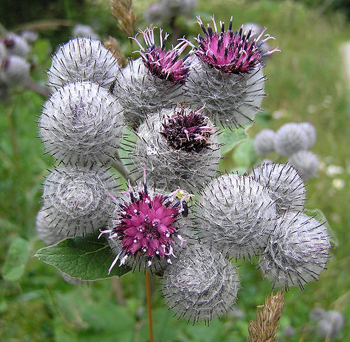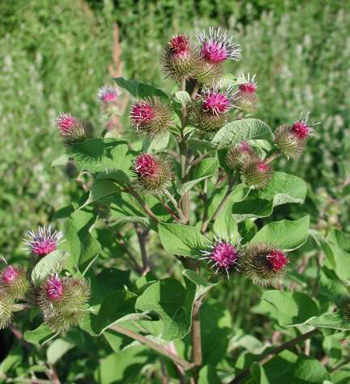Contents:
Common Names | Parts Usually Used | Plant(s) & Culture | Where Found | Medicinal Properties | Biochemical Information
Legends, Myths and Stories | Uses | Formulas or Dosages | Nutrient Content | How Sold | Warning | Resource Links | Bibliography
Scientific Names

- Arctium lappa L.
- Compositae
- Composite family
Common Names
- Bardana
- Beggar’s Buttons
- Burdock Burrs
- Burr Seed
- Burrs
- Cocklebur
- Clodbur
- Clotbur
- Clothburr
- Grass burdock
- Great burdock
- Hardock
- Hareburr
- Hurrburr
- Lappa minor
- Niu bang (Chinese name)
- Personata
- Thorny burr
- Turkey burrseed
Parts Usually Used
Roots, leaves and seeds, the whole plant
Back to Top
Description of Plant(s) and Culture

Burdock is a biennial plant 2-9 feet tall; the root is long, fleshy, gray-brown outside, and whitish inside. In its second year, the plant grows a furrowed, reddish, pithy stem with woolly branches. During the first year burdock has only basal leaves. Both basal and stem leaves are oblong-cordate, heart-shaped, green and hairy on top and downy gray beneath. The purple, thistle-like flowers, 1-1 1/2 inches across, appear in corymbose clusters from July to September. The flowers are long-stalked, in flat-topped clusters. Seedpods (familiar burrs) stick to clothing.
Common Burdock (Arctium minus) is smaller than A. lappa; 2-5 feet. Leaf stems hollow, not furrowed. Flowers smaller (3/4 inch across) without stalks or short stalked; July to Oct. Used extensively by Native Americans. The root and seed have a sweetish, slimy taste, the leaves and stems are bitter.
Back to Top
Where Found
Found in the northern United States and in Europe, along fences, walls, and roadsides, in waste places, and around populated areas. A wide-spread Eurasian weed used in traditional medicine in China, Japan, Europe, and North America.
Back to Top
Medicinal Properties
Alterative, antipyretic, aperient, cholagogue, demulcent, diaphoretic, diuretic, tonic
Back to Top
Biochemical Information
Arctin, biotin, copper, inulin, volitile oils, sulfur, tannins, iron, manganese, vitamins B1, B6, B12, and E, and zinc.
Seeds contain essential fatty acids, vitamins A, B2
Back to Top
Legends, Myths and Stories
This easily-grown plant is quite invasive. Was used as a blood purifier as far back as Shakespeare’s time; it is now used as a root vegetable, it has a taste that combines potatoes and celery.
Once widely used in cleansing remedies, burdock is familiar for its hooked burrs, which readily attach themselves to clothing. This property is reflected in the herb’s botanical name, from the Greek arktos, or bear, suggesting rough-coated fruits, and lappa, to seize. Burdock was a traditional blood purifier, often combined in fold brews such as dandelion and burdock wine, and it was once popular for indigestion. In China, the seeds, niu bang zi, are used to dispel “wind and heat evils”; they also lower blood sugar levels.
Sometimes planted in Japan, where it has been improved by cultivation for its enlarged parsnip-like roots, which are eaten as a boiled vegetable.
Sometimes planted in Japan, where it has been improved by cultivation for its enlarged parsnip-like roots, which are eaten as a boiled vegetable. Burdock is a common European weed; was brought to America as a medicinal plant. It soon became widely scattered, because the burdock seeds attached themselves to colonists’ breeches, clothes and the fur of animals. Millspaugh wrote, “the herb is so rank that man, the jackass, and the caterpillar are the only animals that will eat it.”
Back to Top
Uses
Helps skin disorders, diaper rash, cradle cap, gout. Purifies the blood, restores liver and gallbladder function, kidney, and bladder disorders, syphilis, gonorrhea, diabetes. Relives inflammation. This herb is not narcotic.
The decoction or infusion of burdock root is aperient, but not for all individuals; for some it may even be constipative. Both the tea and the tincture can be used for stomach ailments. Burdock is also said to neutralize and eliminate poisons in the system. The leaves are not generally used but do contain a substance that stimulates the secretion of bile. If they are to be used for liver problems, use fresh leaves only. A decoction of leaves also makes a good wash for sores and may be helpful for acne. The fresh, bruised leaves are sometimes used as a remedy for poison oak or poison ivy. The seeds contain an oil that is used medically, but only with medical supervision. Traditionally, root tea (2 oz. dried root in 1 qt. water) is used as a “blood purifier”, diuretic, stimulates bile secretion, sweating, gout, liver and kidney ailments, nephritis, hypertension, edema, rheumatism, lumbago. Nicholas Culpeper, the famous 17th century herbalist, wrote that it “helpeth those that are bit by a mad dog.”
In China, a tea of leafy branches was used for vertigo, rheumatism, swollen lymph glands, impotence, and (in tea mixed with brown sugar) for measles. Externally, used as a wash for hives, eczema, and other skin eruptions. Seeds are diuretic; used for abscesses, canker sores, sore throats, fever, insect and snake bites, flu, gonorrhea, leprosy, scrofula, sciatica, backache; once used to treat scarlet fever, smallpox, and scrofula. Crushed seeds poulticed on bruises. Leaves poulticed on burns, wounds, ringworm, ulcers, styes, boils, sores. Japanese studies suggest roots contain compounds that may curb mutations (and hence cancer?).
Back to Top
Formulas or Dosages
Collect the root in the spring or fall of the second year; when the plant has a stem. The root may be used fresh or dried.
Burdock poultice: it is good on old skin ulcers and sores. Make the poultice of the root, adding a tsp. of salt; it eases the pain of a wound caused by the bite of a dog. The leaves wilted by the fire, and applied to an external injury, will stop inflammation and ease pain; pounded and put on to a bruise or sprain, it will give immediate relief.
Decoction: use 1 tsp. root with 1 cup cold water. Let stand for 5 hours, then bring to a boil. Take 1 cup a day.
Tincture: Take 10-25 drops, in water, camomile tea, or regular tea, 3-4 times a day.
Juice: Grate the fresh root and add half again as much water. Squeeze out the liquid. Drink 1 cup a day, a mouthful at a time.
Back to Top
Nutrient Content
Iron, manganese, vitamins B1, B6, B12, and E, and zinc.
Back to Top
How Sold
Juice: Grate the fresh root and add half again as much water. Squeeze out the liquid. Drink 1 cup a day, a mouthful at a time.
Powder: use 1/2 tsp. twice daily in a glass of water.
Capsules: take 1 to 3 daily.
Extract: mix 10 to 25 drops of extract in liquid daily.
Back to Top
Warning
Leaf hairs may irritate skin. Do not confuse leaves with the toxic leaves of Rhubarb. Care should be taken if anemia exists.
Back to Top
Resource Links
LiveStrong.com: Burdock & Skin Problems
LiveStrong.com: Burdock Root & Eczema
LiveStrong.com: Burdock & Echinacea
LiveStrong.com: Burdock & the Liver
University of Maryland Medical Center: Burdock
Memorial Sloan-Kettering Cancer Center: Burdock
U.S. National Library of Medicine: Burdock
Bibliography
![]() The Herb Book
The Herb Book, by John Lust, Bantam Books, 666 Fifth Avenue, New York, NY. copyright 1974.
![]() The Complete Medicinal Herbal
The Complete Medicinal Herbal, by Penelope Ody, Dorling Kindersley, Inc, 232 Madison Avenue, New York, NY 10016, First American Edition, copyright 1993
![]() Eastern/Central Medicinal Plants
Eastern/Central Medicinal Plants, by Steven Foster and James A. Duke., Houghton Mifflin Company, 215 Park Avenue South, New York, NY 10000
![]() The Herbalist Almanac
The Herbalist Almanac, by Clarence Meyer, Meyerbooks, publisher, PO Box 427, Glenwood, Illinois 60425, copyright 1988, fifth printing, 1994
Herbal Gardening, compiled by The Robison York State Herb Garden, Cornell Plantations, Matthaei Botanical Gardens of the University of Michigan, University of California Botanical Garden, Berkeley., Pantheon Books, Knopf Publishing Group, New York, 1994, first edition
 The Magic of Herbs
The Magic of Herbs, by David Conway, published by Jonathan Cape, Thirty Bedford Square, London, England. (Out of print)
![]() Back to Eden
Back to Eden, by Jethro Kloss; Back to Eden Publishing Co., Loma Linda, CA 92354, Original copyright 1939, revised edition 1994
![]() Culpeper’s Complete Herbal & English Physician: Updated With 117 Modern Herbs
Culpeper’s Complete Herbal & English Physician: Updated With 117 Modern Herbs, by Nicholas Culpeper, Meyerbooks, publisher, PO Box 427, Glenwood, Illinois 60425, 1990, (reprint of 1814)
 Old Ways Rediscovered
Old Ways Rediscovered, by Clarence Meyer, Meyerbooks, publisher, PO Box 427, Glenwood, Illinois 60425, published from 1954, print 1988
 Earl Mindell’s Herb Bible
Earl Mindell’s Herb Bible, by Earl Mindell, R.Ph., Ph.D., Simon & Schuster/Fireside, Rockefeller Center 1230 Avenue of the Americas, New York, New York 10020
![]() Indian Herbalogy of North America
Indian Herbalogy of North America, by Alma R. Hutchens, Shambala Publications, Inc., Horticultural Hall, 300 Massachusetts Avenue, Boston, Massachusetts 02115, 1973
![]() Planetary Herbology
Planetary Herbology, by Michael Tierra, C.A., N.D., O.M.D., Lotus Press, PO Box 325, Twin Lakes. WI 53181., Copyright 1988, published 1992
![]() American Folk Medicine
American Folk Medicine, by Clarence Meyer, Meyerbooks, publisher, PO Box 427, Glenwood, Illinois 60425, 1973
![]() Prescription for Nutritional Healing, Fifth Edition: A Practical A-to-Z Reference to Drug-Free Remedies Using Vitamins, Minerals, Herbs & Food Supplements
Prescription for Nutritional Healing, Fifth Edition: A Practical A-to-Z Reference to Drug-Free Remedies Using Vitamins, Minerals, Herbs & Food Supplements, by James F. Balch, M.D. and Phyllis A. Balch, C.N.C., Avery Publishing Group, Inc., Garden City Park, NY
![]() Webster’s New World Dictionary
Webster’s New World Dictionary, Third College Edition, Victoria Neufeldt, Editor in Chief, New World Dictionaries: A Division of Simon & Schuster, Inc., 15 Columbus Circle, New York, NY 10023
 How Indians Use Wild Plants for Food, Medicine & Crafts
How Indians Use Wild Plants for Food, Medicine & Crafts, by Frances Densmore, Dover Publications, Inc., 180 Varick Street, New York, NY 10014, first printed by the United States Government Printing Office, Washington, in 1928, this Dover edition 1974
 An Instant Guide to Medicinal Plants
An Instant Guide to Medicinal Plants, by Pamela Forey and Ruth Lindsay, Crescent Books (January 27, 1992).
 The Magic of Herbs in Daily Living
The Magic of Herbs in Daily Living, by Richard Lucas, Parker Publishing Co. (1988).
![]() The Yoga of Herbs: An Ayurvedic Guide to Herbal Medicine
The Yoga of Herbs: An Ayurvedic Guide to Herbal Medicine, by Dr. David Frawley & Dr. Vasant Lad, Lotus Press, Twin Lakes, Wisconsin, Second edition, 1988.
 The Rodale Herb Book: How to Use, Grow, and Buy Nature’s Miracle Plants (An Organic gardening and farming book)
The Rodale Herb Book: How to Use, Grow, and Buy Nature’s Miracle Plants (An Organic gardening and farming book), edited by William H. Hylton, Rodale Press, Inc. Emmaus, PA, 18049., 1974
